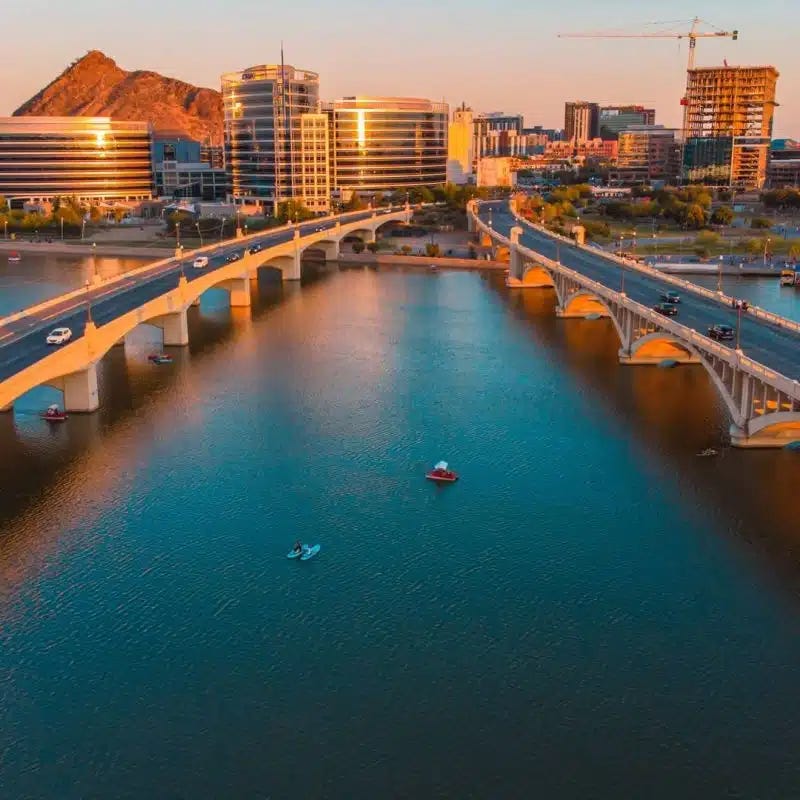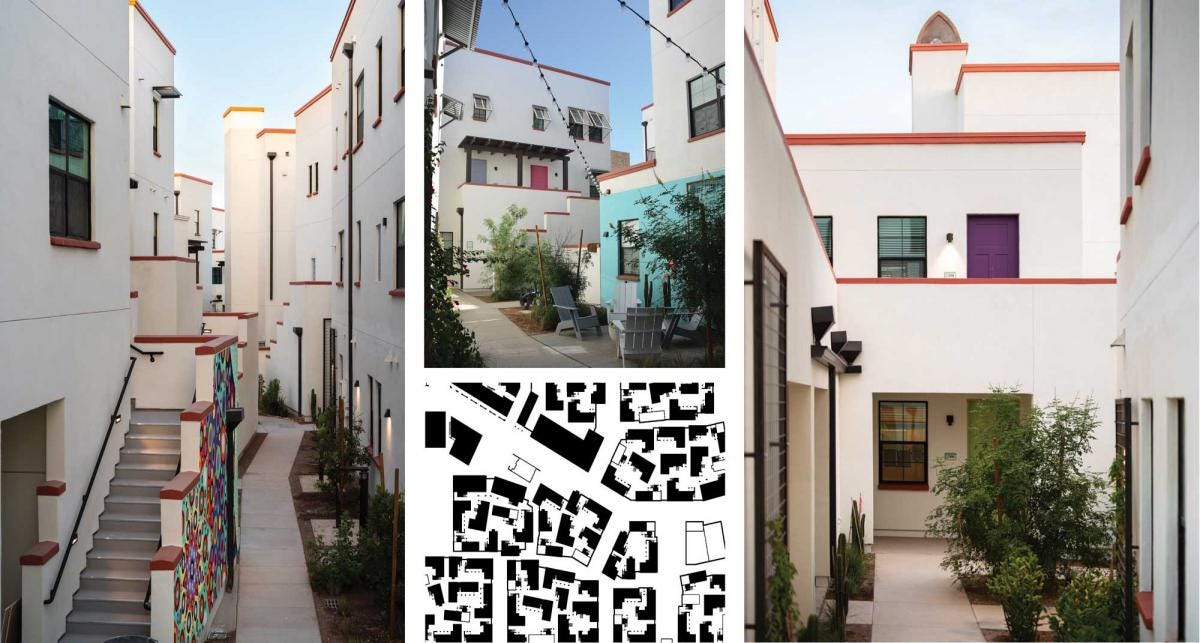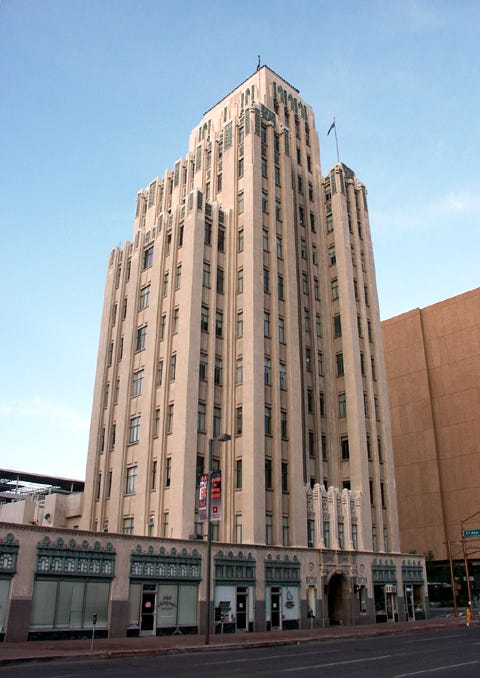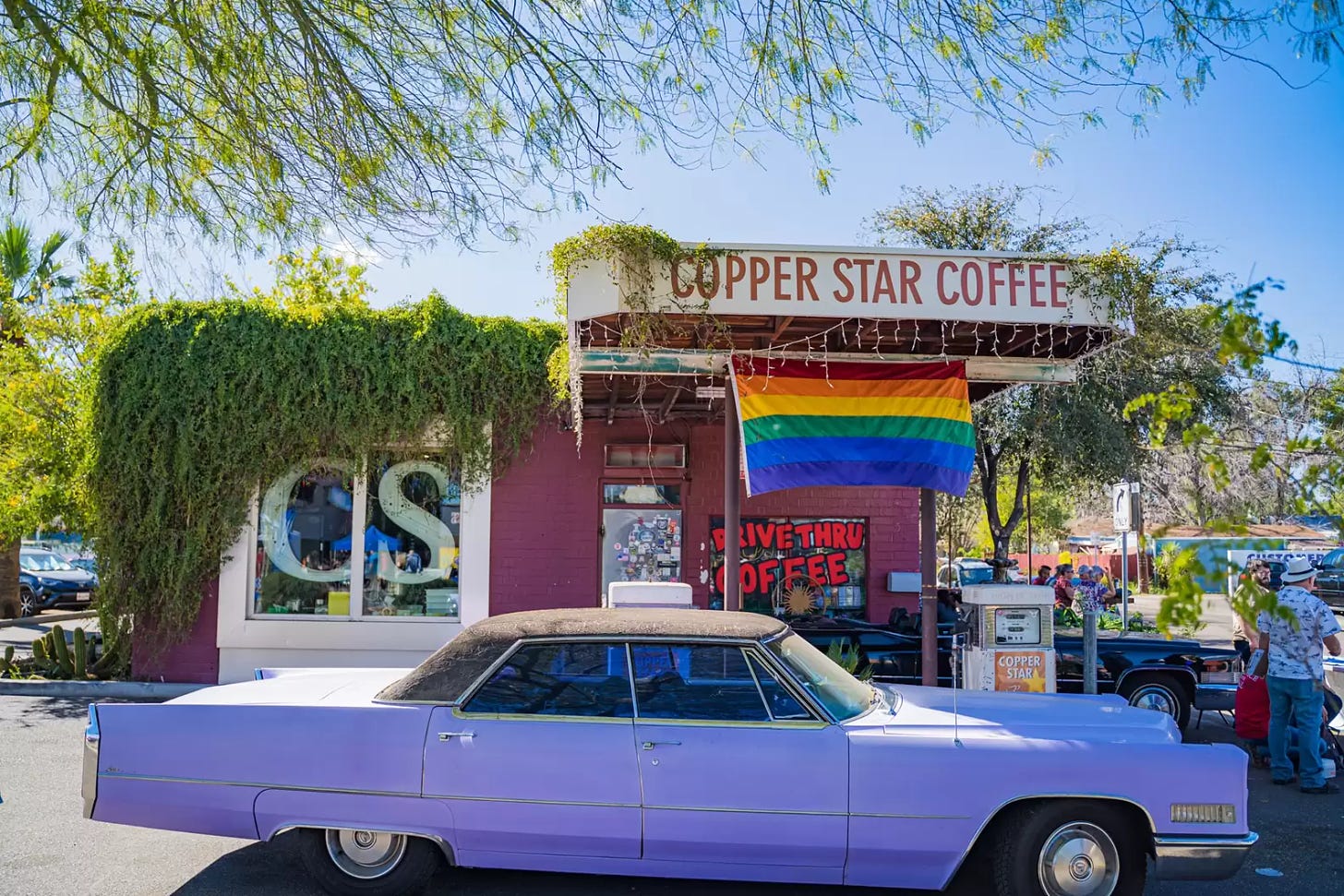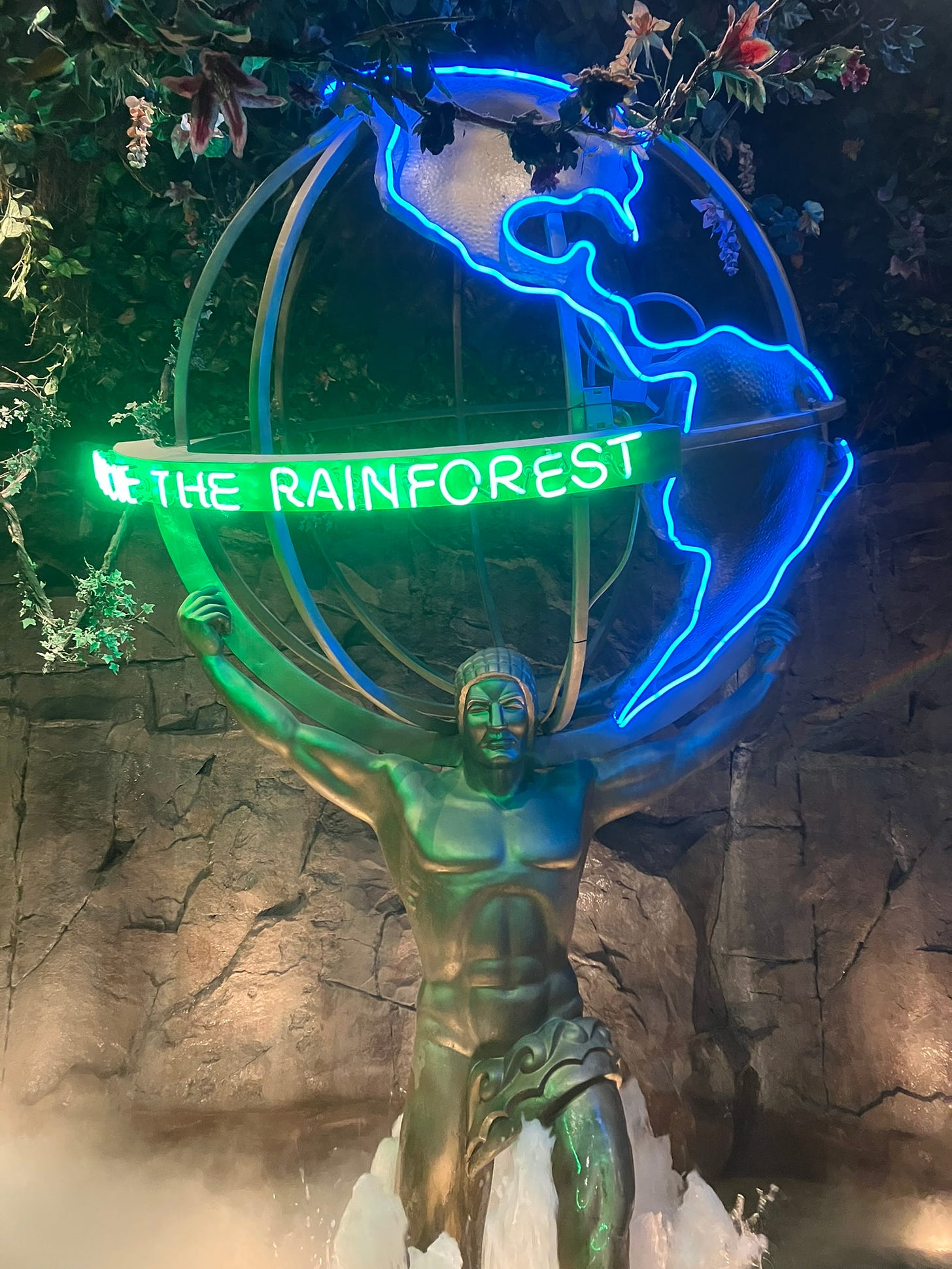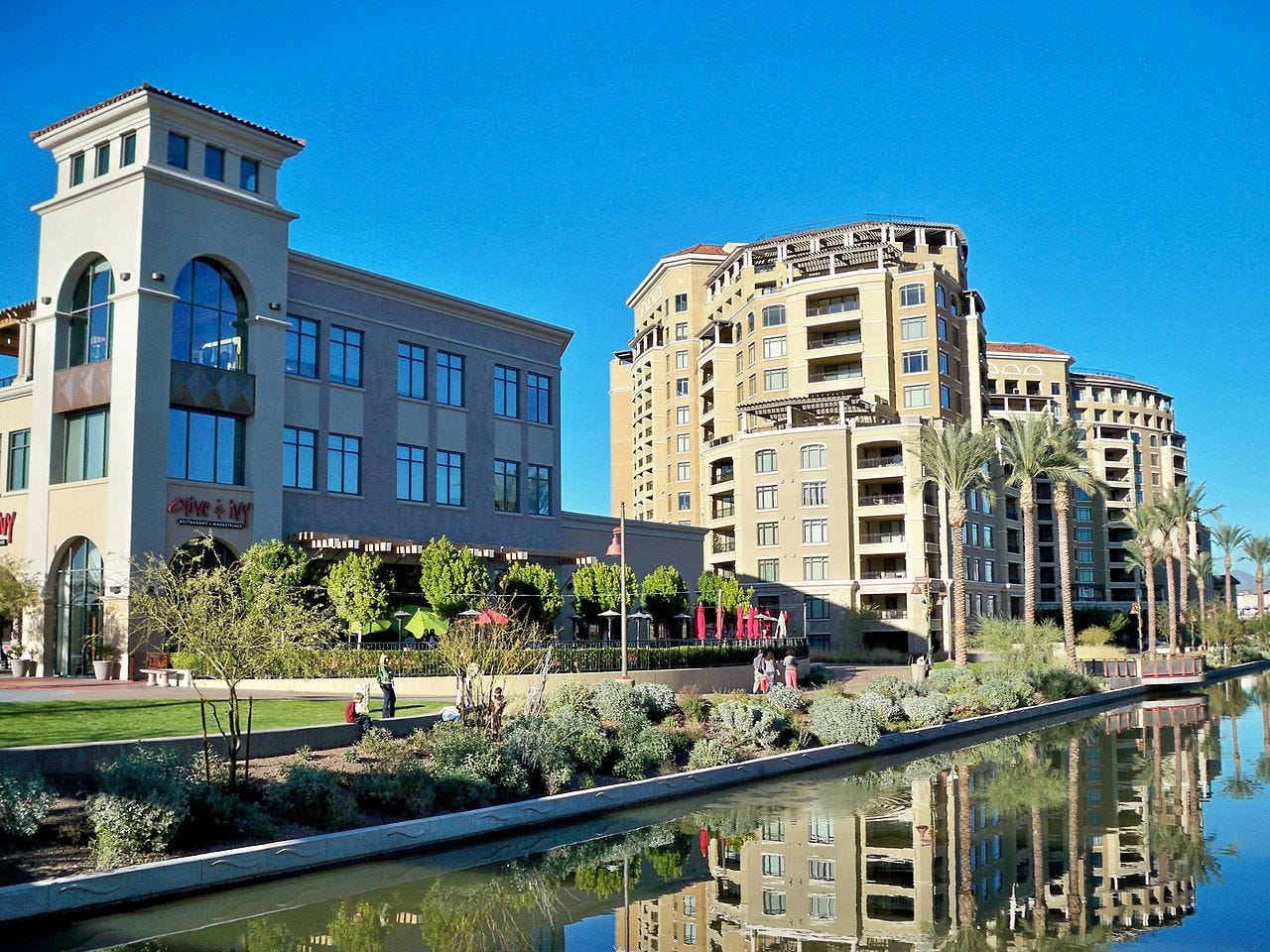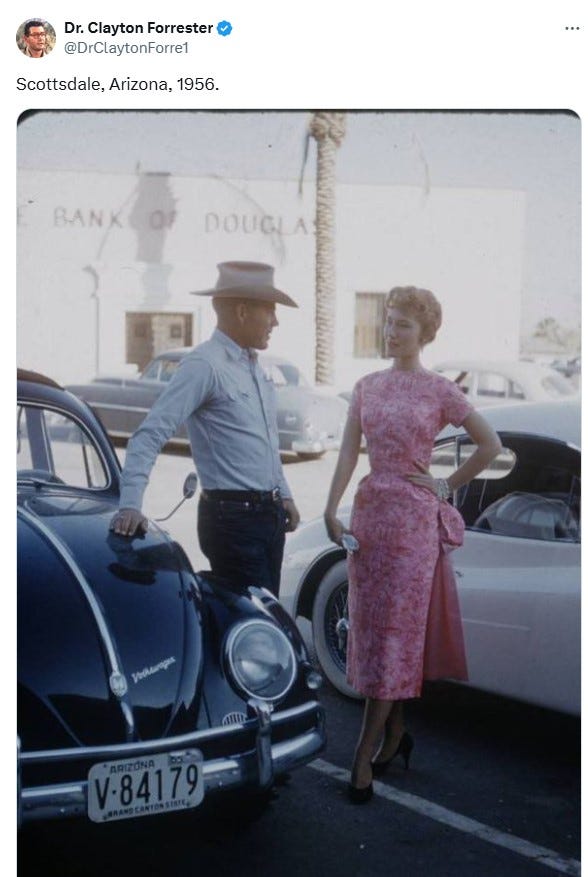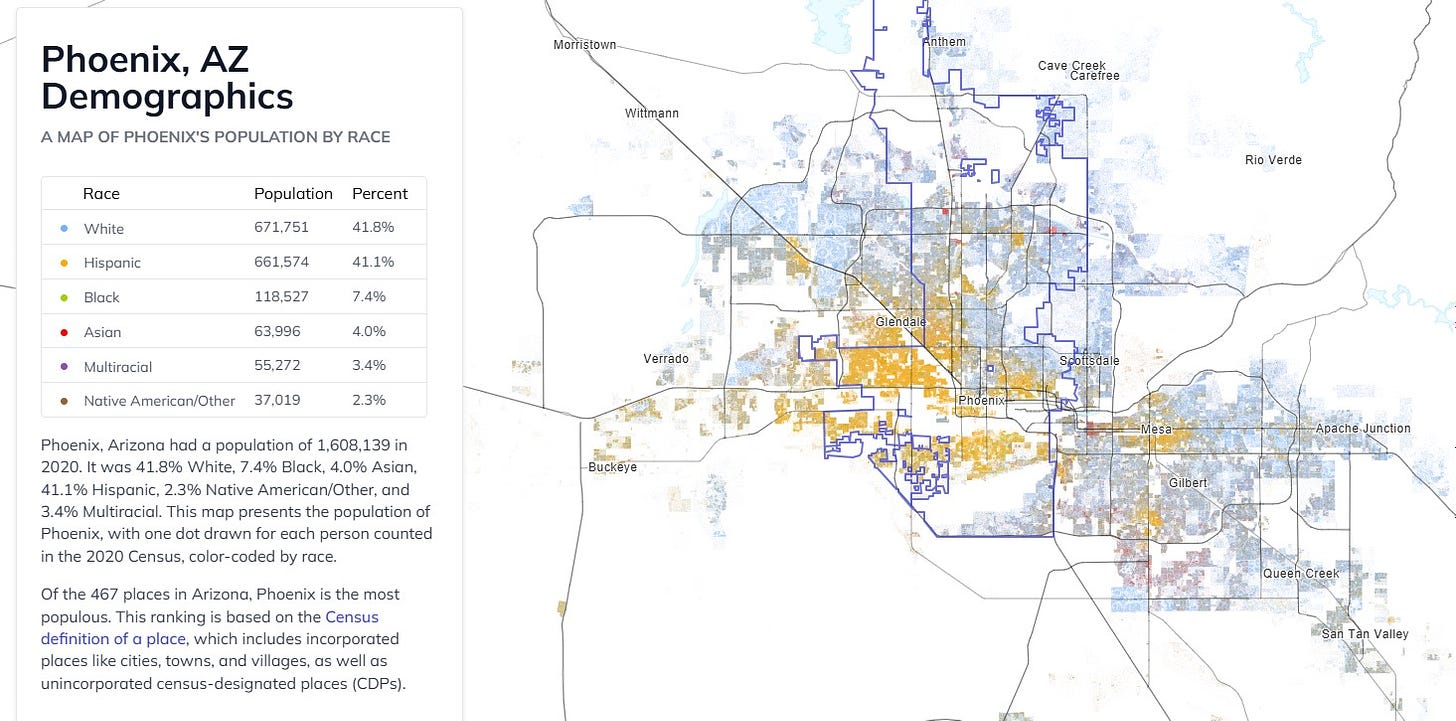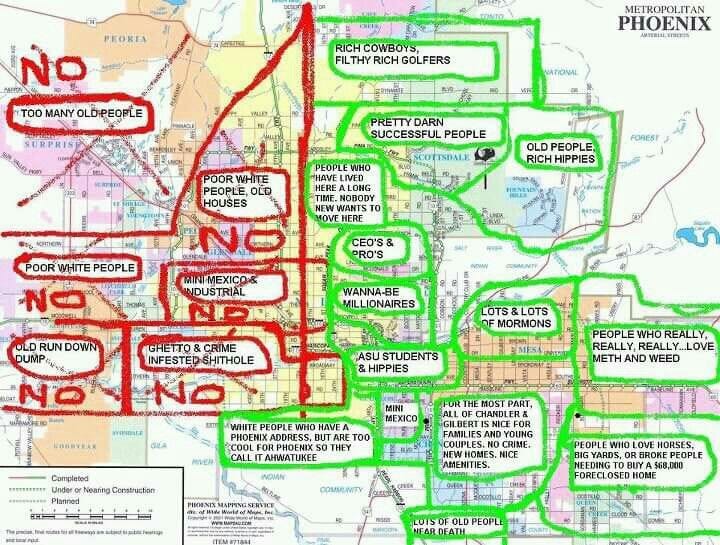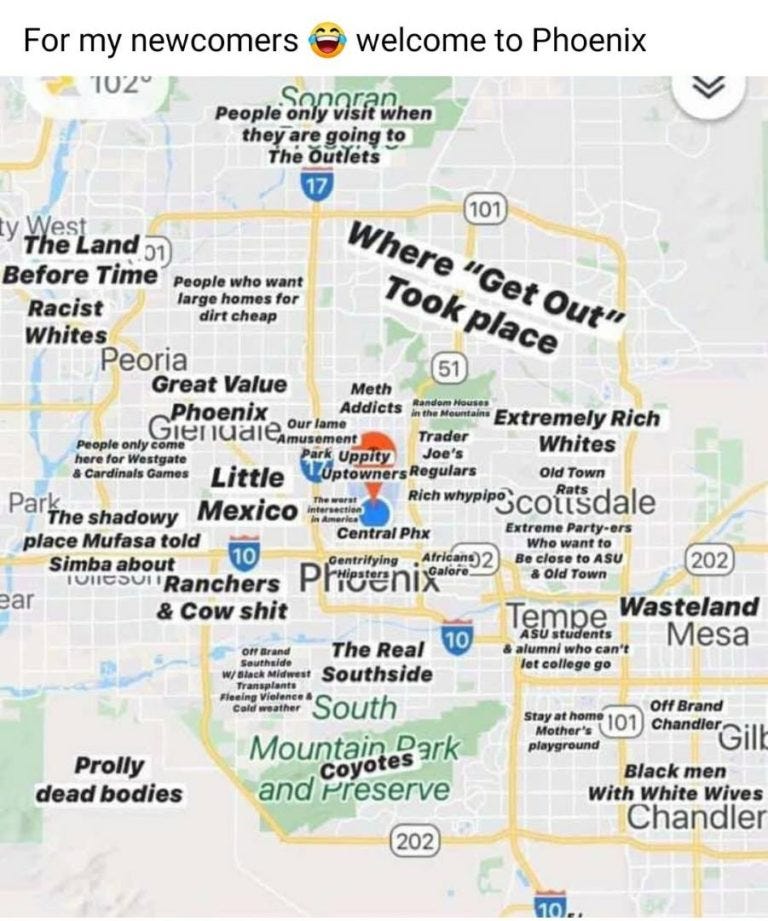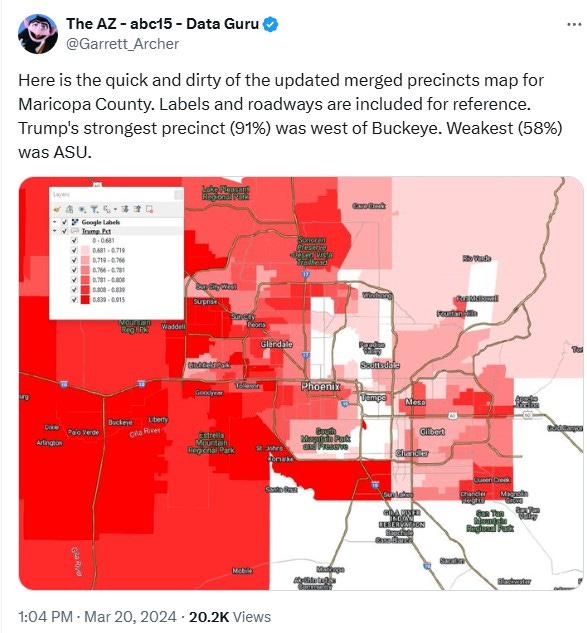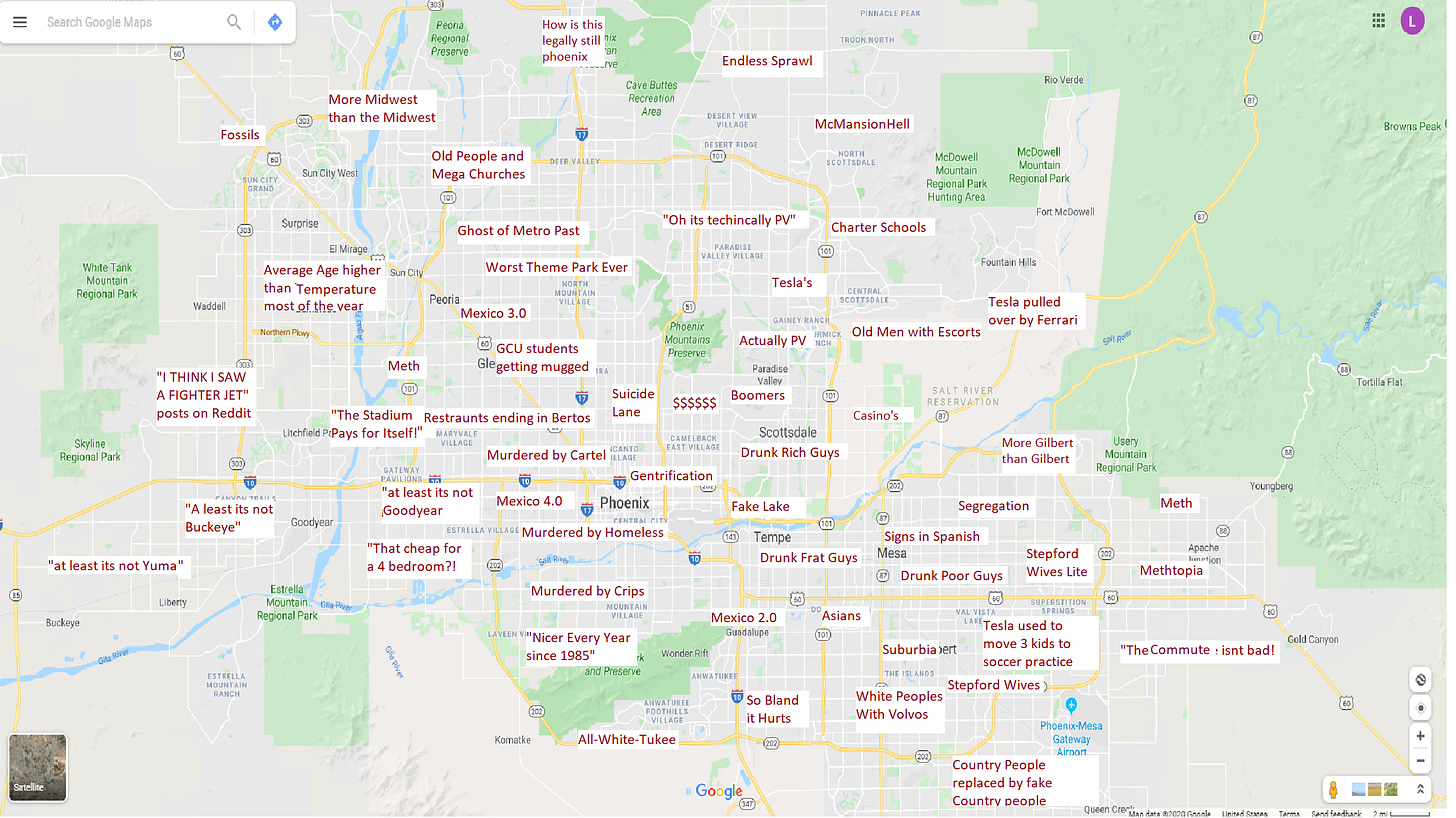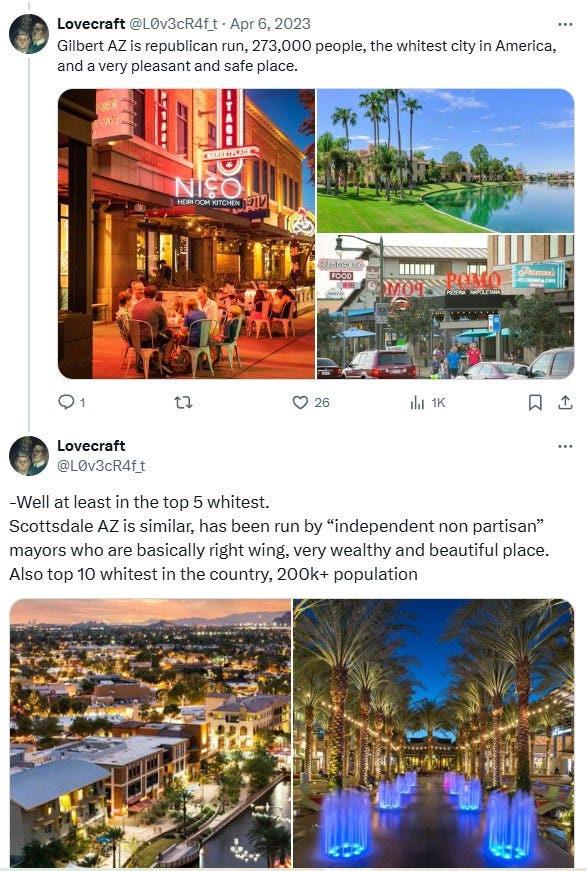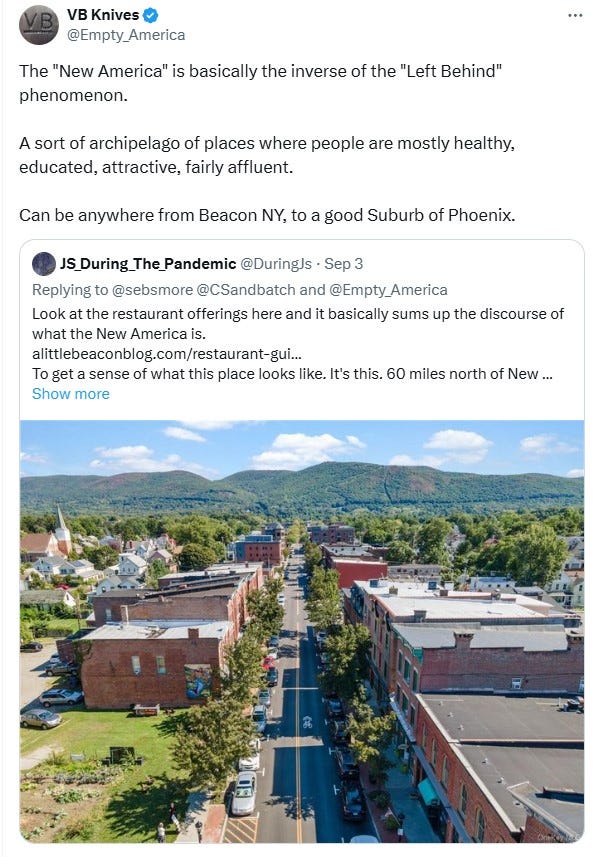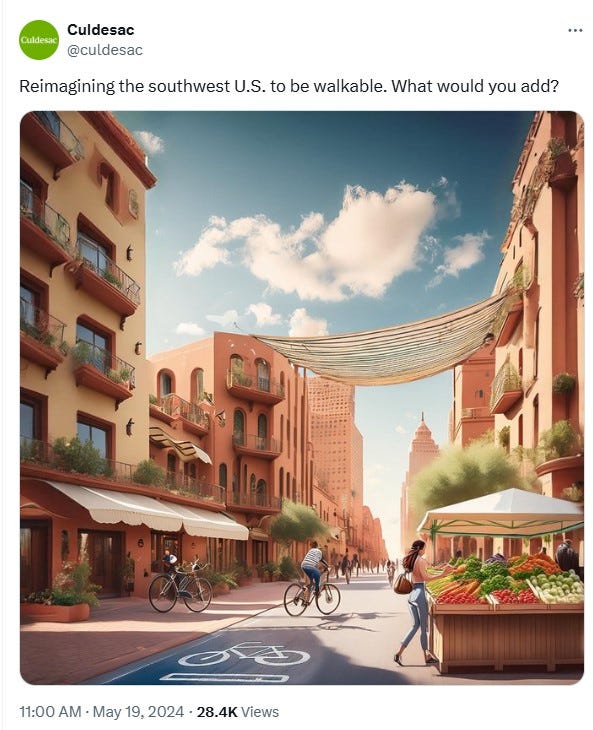Kim & Jessie by M83 was the song of the trip.
Last weekend was my second time visiting Phoenix, Arizona, after flying in and briefly staying there on a trip to Sedona last Fourth of July Weekend. Phoenix is the fifth most populous city in the Nation, and Maricopa County is the fourth most populous county, which is surprising considering how unurban most of Phoenix feels. Phoenix was selected as Arizona’s capitol because it is centrally located between the lumber industry in the north and the mining industry in the south, with Flagstaff in the north and Tucson in the south being more established and historic cities.
source: @covina1man on X
Just driving from LA through the Inland Empire to the Phoenix suburbs, the stretch of sprawl feels almost as vast as the stretch of open desert. However, that feeling is exacerbated by being in traffic. Despite Phoenix’s sprawl, the metro is surrounded by natural beauty with Saguaro cacti which are magical to see for the first time in the desert, and mountain ranges, though not as dramatic as the mountains around Las Vegas. You still feel that you are in the desert while among the sprawl.
source: R/EarthPorn
I spent most of the trip in the Phoenix suburb and college town of Tempe, where Arizona State is. Tempe is where you find Hipsters, college students, and more liberal and cosmopolitan types. The arts and culture scene in Tempe is a good counterbalance to the philistine nature of Phoenix, even if Tempe is more liberal.
Downtown Tempe & The Salt River
Photo Credit: bhaumik_bheda via Instagram
Phoenix is a fairly new city that wasn’t built up until the invention of air conditioning in the post-war period. Downtown Tempe is the one place in the Phoenix metro that is truly walkable, urban, and cosmopolitan. Tempe has the metro’s highest concentration of charming historic architecture but also has an impressive amount of new high-rise construction, with a new skyline rivaling many mid sized cities. Tempe was surprisingly ranked one of the most eco-friendly cities in the US, with a car-free new urbanist neighborhood called Culdesac.
Culdesac, Tempe
source: Congress of New Urbanism
There are some historic Art Deco buildings Downtown, and a decent amount of mid-century modern architecture throughout Phoenix. There is also a lot of new high-rise construction downtown and various attempts at revitalization. Traditionally Downtown has mostly just been government offices, with not much going on in terms of urbanism or nightlife.
Art Deco style Luhrs Tower in Downtown Phoenix
source: wikipedia.org
Melrose District
source: GayTravel4U
Midtown just north of Downtown is becoming trendy and gentrifying, with the up and coming Hipster area, Encanto Village and the Melrose District, which is Phoenix’s Gayborhood. However, these areas do not compare to Downtown Tempe in terms of nightlife. For being such as car centric city, Phoenix actually has a rather extensive light rail system. Like San Francisco, Phoenix has these self-driving autonomous taxis, which shows that it is ahead of the curb on innovation.
The Rainforest Cafe at the Arizona Mills Mall in Tempe
Photo credit: Robert Stark
I spent some time at the Arizona Mills Mall in Tempe which has a reputation as prole coded, though I still had a lot of fun visiting. However, I noticed a decent amount of middle class coded families, both White and Latino. Fashion Square in Scottsdale is the upper class coded White coded mall. I did not get a chance to visit Scottsdale, but plan to on my next trip.
Scottsdale has a reputation as nouveau riche and crassly materialistic, though has a charming downtown with Old West style architecture, as well as some new urbanist development. Scottsdale has a stereotype for having a lot of attractive but conceited upper class coded blonde women. Scottsdale also has one of the highest concentrations of Canadian expats in the US. Nearby Paradise Valley is slightly more old money, albeit by Phoenix standards, and has these massive palatial estates that look like Roman Palaces.
Scottsdale
source: wikipedia.org
source: @DrClaytonForre1 onX
Phoenix’s top immigrant groups are from Mexico, India, Canada, the Philippines, China, Vietnam, Guatemala, the United Kingdom, Iraq, and Germany. Despite Phoenix being only 3.9% Asian and not traditionally having tons of East Asians, Phoenix had the 2nd fastest Asian growth of any metro, with half of Phoenix’s Asian population being foreign born. While Phoenix does not have any major Asian enclave or ethnoburb, the Southeastern suburbs of Mesa and Chandler have the highest concentration of Asians. Recently the northern suburbs are attracting Taiwanese immigrants recruited to work in semiconductor chip manufacturing, which is a booming industry. There was a recent lawsuit that alleges that a Phoenix chip factory discriminated against non-Taiwanese employees.
source: censusdots.com/race/phoenix
Indians are Phoenix’s 2nd largest immigrant group and have communities in Tempe and Chandler, with many working in tech. On the drive back, I ate at an Indian restaurant in a trailer at a truck stop in the middle of the Arizona Desert that had good and affordable Indian food and catered to blue collar Sikh truck drivers. I also noticed that a lot of the mall kiosks have Muslim women in headscarves working there.
Phoenix is a very Latino city at 42.6%. In contrast with LA, I got strong Northern Mexican vibes from the Mexicans in Phoenix, as Arizona has strong demographic ties to nearby Sonora, Mexico. Steve Sailer describes these types of Mexicans with big pickup trucks and cowboy hats as hyper Texans. This Mexican demographic is lighter complexion and has a more machismo mentality compared to the heavily indigenous Southern Mexicans and Guatemalans, who tend to be more docile, mild mannered, and collectivist. You do notice the latter in Phoenix, especially running the non-licensed taco stands, but in much smaller numbers than in LA.
source: pinterest.com
A lot of old school Chicanos from LA relocated to Phoenix, as well as Las Vegas, and Texas. Steve Sailer has pointed out that one of the reasons that LA became safer is that more docile Southern Mexicans and Guatemalans displaced more aggressive Blacks and old school Chicanos, think Danny Trejo’s characters. However, Phoenix also has a much stronger middle class coded Latino culture than in LA.
While race relations have gotten much worse between Whites and Blacks, my impression is that race relations have improved between Whites and Hispanics. The Castizo Futurism meme, of a growing ethnogenesis and cultural fusion between Whites and Hispanics, is happening in places like Arizona and Texas, and California to a lesser degree. While Phoenix is only 7.1% Black and Blacks are not concentrated in any particular neighborhood, I noticed a decent number of Blacks, both ghetto coded and middle class coded. Many of Phoenix’s Blacks are likely a product of Black flight out of LA.
Funny but Accurate Black Community Map of Phoenix
source: phxsoul.com
Mirroring a national trend, Arizona’s Latino Demographic shifted majorly toward Trump (by 43%). Previous to the Latino pivot toward Trump in Arizona, there was a Latino backlash against Arizona’s tough anti-illegal immigration laws and Sheriff Joe Arpaio, which initially benefited Democrats. Arizona’s anti-illegal immigration movement was sort of a spillover from California’s failed anti-illegal immigration movement due to all the conservative White flight transplants.
source: @Garrett_Archer on X
Arizona is a purple state that is now tilting slightly red while Maricopa County is now close to evenly divided between liberals and conservatives. Donald Trump won the County by a narrow margin after it went Democrat in previous elections. Kamala Harris won the City of Phoenix plus Tempe while Trump won the suburbs, including some very Latino suburbs. Arizona and the Phoenix metro have a libertarian streak, as far as there are both marijuana dispensaries and gun stores everywhere, but also tend to vote in tough on crime legislation. I would describe Phoenix as a cultural hybrid between LA, Las Vegas, and Texas.
Phoenix feels much more clean than California’s metros, despite having a large prole element. There are a lot of homeless people but they tend to be spread out and there are not many encampments. Phoenix does not have a traditional geographically defined ghetto like LA’s South Central but rather bad areas that are spread out in pockets of suburban sprawl. Basically, suburban areas that used to be middle class coded decayed into ghettos. For instance, Maryvale is a neighborhood northwest of Downtown toward Glendale that now has a reputation as one of the worst areas of Phoenix. Even some areas near Downtown and the Airport seemed ghetto, and parts of South Phoenix like South Mountain have a bad reputation.
Totally Incorrect Judgement Map of Phoenix
source: R/Phoenix
Phoenix is 42.2% White while Maricopa County is 53.3% White, so it is diverse but much Whiter and more middle class coded than LA or the Bay Area. Phoenix is a major White flight destination from SoCal with a lot of middle and upper middle class White families, as well as a lot of retirees. Both ritzy Scottsdale and the more middle class coded southeastern suburb of Gilbert are some of the Whitest cities in America. Gilbert is also one of the most Mormon places outside of Utah.
source: @L0v3cR4f_t on X
While the future of Phoenix is more non-White, expect Mormons to dominate Phoenix’s White population due to higher fertility increasingly. Phoenix also seems to have a much stronger White middle class demographic than Las Vegas, which has many similarities. However, Phoenix is fairly deracinated like SoCal and much of the Sun Belt, due to having so many transplants and new development.
When I was at the mall, the one thing that stood out in contrast to California, was there were families with children everywhere, including Latinos with as many as 3 to 4 kids, and Whites with 2 and sometimes 3 kids. I also noticed working class coded White families with kids, which you don’t see much of in SoCal, except in far out exurbs. California’s population is rapidly aging, with Latino fertility crashing as well. Arizona’s fertility rate is 1.63 compared to 1.53 for California, Arizona’s White fertility rate is 1.47 compared to 1.36 for California, and Arizona’s Latino fertility rate is 1.81 compared to 1.62 for California.
Phoenix’s pro-housing policies are broadly natalist and pro-population growth, across racial and class demographic lines. In contrast, California’s nimbyism ironically suppresses White family formation while also keeping out a lot of new immigrants. While Phoenix’s sprawl is an ecological disaster, it produces abundant housing which can be harder to create with just infill and mixed-use urbanist development. With the abundance of housing and space, it seems that every demographic group can carve out their niche. In contrast, California’s housing scarcity creates a nasty zero sum competition, of the wealthy against middle and lower classes, the old against the young, and various ethnic demographics at each other’s throats.
While driving into Phoenix from LA at 4 am, there was a car driving opposite traffic on the highway with police chasing the driver. This is emblematic of a sort of chaotic restless energy that goes back to the Old West Days. Despite this, people in Phoenix across demographic lines generally seem fairly laid back and friendly.
source: @Empty_America on X
At least for now, The Sunbelt appears to be America’s future, economically, politically, and culturally. For instance, Phoenix’s millionaire population doubled over just the last decade. However, Phoenix was hard hit by the 08’ recession and has vulnerabilities to another real estate crash, after the pandemic remote work boom inflated the housing market. While I used to be a snob about only liking coastal walkable cities, I can appreciate the vitality of Phoenix, as California is so stagnant and such a gerontocracy. Not to mention that the recent wave of remote workers from California is creating further demand for more trendy cosmopolitan amenities.
source: @culdesac on X
Phoenix will have to deal with existential ecological issues in the future, including water scarcity, climate change, and possibly peak oil. Phoenix will have to retrofit sprawl into sustainable compact walkable communities, as well as return some exurban subdivisions to open desert. This will be a very difficult and costly process, considering how massive Phoenix’s sprawl area is. The mythological symbolism of Phoenix as rising from the ashes is significant, though it didn’t rise from the ashes but rather was built up from scratch and then had to reinvent itself.



